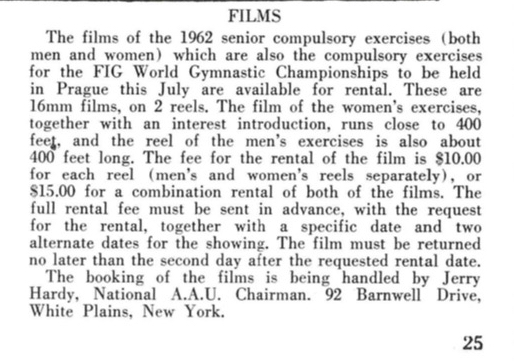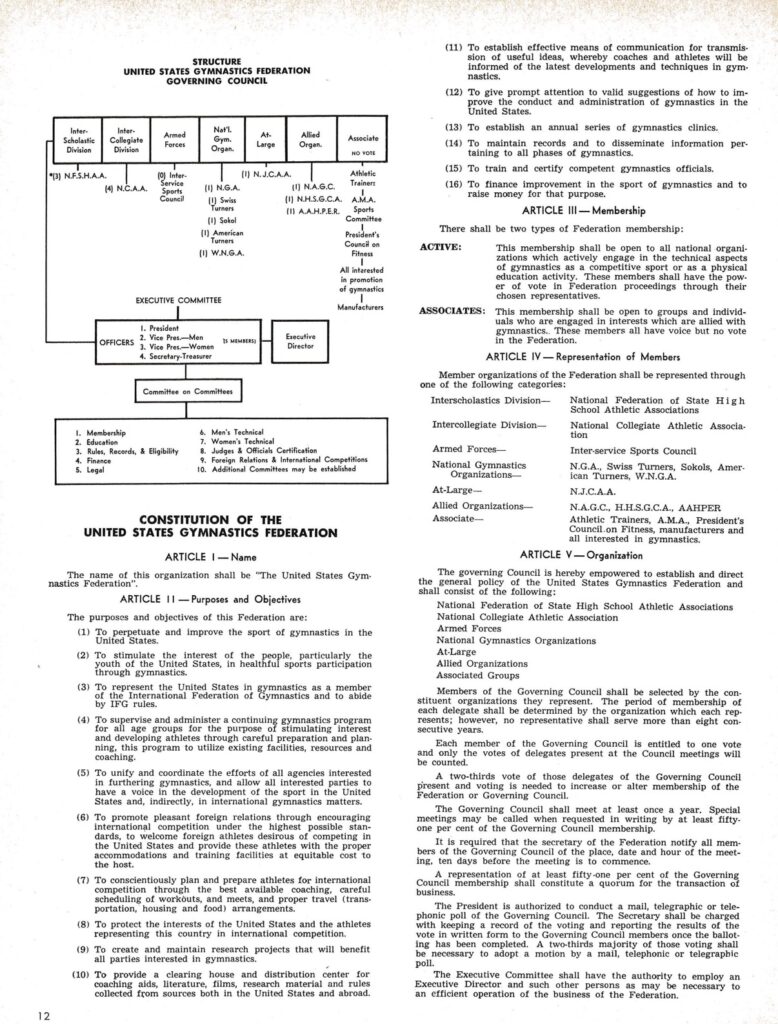The first blog on this site starts in 1962 because some gymnastics fans want to burn down USA Gymnastics. In the unlikely event that happens, it would not be the first time that the national governing body for gymnastics would be overthrown.
In 1962, the United States Gymnastics Federation was formed in an effort to replace the AAU as the official governing body of gymnastics in the United States, and I thought that it would be fun to revisit that history.
What follows are Cliffs Notes. If you want to know more, check out A History of the Development of the United States Gymnastics Federation by Richard Edd Laptad. USA Gymnastics also has its own timeline here.
What Is the AAU?
Founded in 1888, the Amateur Athletic Union (AAU) was the governing body for most sports in the United States, including gymnastics. Generally speaking, here’s what the organization was responsible for:
- Defining and enforcing amateur codes
- Providing continuity and direction to rules development
- Establishing and directing Olympic programs, both nationally and internationally
- Serving as a liaison between the United States and international organizations like the Fédération Internationale de Gymnastique (FIG).
The gymnastics community agreed that the AAU wasn’t a total waste of space. In an article in the Modern Gymnast, Jim Farkas acknowledged the organization’s merits. The AAU had
- Aided the growth of gymnastics in the United States
- Introduced FIG rules and standardized competition formats accordingly
- Assembled first-class competitive teams for competitions
But…
We’ll get to the “but” in a second.
What Is the NAGC?
In 1950, the U.S. coaches organized to form the National Association of Gymnastic Coaches (NAGC). It included NCAA college coaches, judges, and high school coaches.
Though the organization had an important role in the development of the sport, they had little voice in the regulation, supervision, and selection of the U.S. teams.
They considered the AAU’s leadership to be authoritarian, which is reflected in the two letters from the February 1962 issue of the Modern Gymnast.


Remember: Life was different in the 1960s. You couldn’t go online and download the Code of Points. The AAU was the gatekeeper of all things gymnastics. For example, the organization had to obtain copies of the Code of Points from the FIG and disseminate them to members. To see the compulsory routines, gymnasts and coaches had to rent films from the AAU.

The 1961 Resolution
Outside the gymnastics community, frustration with the AAU came to a head as the result of a basketball situation, but as gymnastics fans, we don’t care about sportsballz. Here’s what happened in the gymnastics world.
At the April 1961 NAGC meeting, the organization adopted a resolution, in which they stated the following:
- The AAU was “woefully lacking and inefficient in the dissemination of information,” resulting in coaches looking elsewhere for help
- The AAU Gymnastic Committee meetings were conducted in a “dictatorial” manner without opportunity for discussion
- The Gymnastics Committee Chairman (George J. Gulack) lacked leadership skills, resulting in “no unity whatsoever” in U.S. gymnastics
- Gulack was in office because he was appointed by the AAU president—not because the gymnastics coaches wanted him there
(Among other things)
The NAGC demanded Gulack’s immediate resignation. If that didn’t happen by December of 1961, the NAGC threatened to withdraw its support for the AAU.
An Aside
U.S. coaches believed that the AAU was too focused on the FIG rules and international competition. As a result, the AAU leadership hadn’t taken the time to create a system for developing young gymnasts who weren’t at upper echelon of the sport.
Here’s an editorial from the April 1962 issue of the Modern Gymnast that expands on this point:

Mmhmm, you guessed it. This is why we now have levels 1 through 10 in the United States. (Some of you may even remember the old class system.)
Back to the Action: The Formation of a Constitution
Guess what? Remember the man whom the NAGC wanted to resign? Gulack?
Yeah, well, Gulack, the Olympic Gymnastics Committee Chairman, didn’t resign. In fact, despite the NCAA’s and the NAGC’s best efforts, Gulack was re-elected in December of 1961 by a 7-6 vote during the Quadrennial Meetings of the United States Olympic Commitee.
Immediately after the vote, the NCAA delegation
- Called a recess
- Then decided to remain in indefinite recess
- File a formal statement of dissatisfaction to the NCAA and United States Olympic Association
After several meetings between the NCAA, AAU, and the USOC, the NCAA realized that compromise was not possible and asked the NAGC to begin working on a new federation in March of 1962.
The organization’s preliminary structure was printed in the May/June 1962 issue of the Modern Gymnast.

As was the draft of the Constitution.


The Jan/Feb 1963 of Modern Gymnast opened with a 6-page spread on the USGF. The feature included a letter from the the Frank Bare (executive director), an article from Donald Boydston (president), and the official constitution.






“We are far behind the Russians and Japanese.”–Donald Boydston
That line indicates where the USGF had its focus: the men. If it had been focused on the women, it would have said, “We are far behind the Russians and Czechoslovaks.”
A Premature Attempt at FIG Recognition: The 1962 World Championships
I can’t wake up one day, start the Uncle Tim Gymnastics Federation, and compete at international events. I would need the FIG to recognize my organization.
That’s why the USGF immediately tried to get FIG recognition in 1962.
Here’s the TL;DR of what happened:
- NAGC President Gene Wettstone obtained the addresses of FIG officials and wrote them letters
- Two NAGC delegates went to the 1962 World Championships in Prague, hoping to plead their case during the FIG Congress
- They didn’t get the meeting, but the AAU representatives mentioned the USGF at the FIG Congress, speaking poorly of the organization
- The FIG asked that the AAU refrain from making such statements without USGF representatives present
FIG Recognition: Arthur Gander’s Support
The irony in the story is that George Gulack, the very man the NAGC opposed in 1961, would become the USGF’s biggest champion in the FIG.
Turning Point #1: George Gulack became FIG Vice President for the Americas in 1964. In 1965, he told the FIG Executive Committee:
- The AAU was uncooperative, failing to aid in the translation and reproduction of compulsory routines
- The AAU was practically non-existent and the USGF truly represented gymnastics in the U.S.
My take: The AAU had pissed off the wrong person. Colonel Donald Hull, Executive Director of the AAU, tried to replace Gulack with Tom Maloney as FIG Vice President. The FIG has always been highly political, and methinks Gulack didn’t like the attempt at an ouster.
Gulack’s stance: In an interview with Laptad, Gulack maintained that he switched his allegiance from the AAU to the USGF because he had only one true loyalty–to the improvement of gymnastics in the United States. And the AAU was not properly supporting and developing gymnastics in the United States.
Turning Point #2: In 1967, Arthur Gander (FIG President) and Gulack spoke at the USGF Coaches Congress, and Gander was able to see how the USGF operated in person. At the time, the FIG Executive Committee could take no action.
I’ll spare you the nitty-gritty details. Suffice it to say that, in 1970, the FIG officially recognized USGF as the national governing body of gymnastics in the United States.
(BTW, the USGF would be rebranded as USA Gymnastics in 1993.)
Morals of the Story
- Overtaking an existing governing body is a long, messy process; it took 8 years for the USGF to get recognized by the FIG
- Your enemy today could become your ally tomorrow; Gulack was once the enemy of the NAGC before becoming its proponent
Anyway, stay tuned for more from the 1962 gymnastics archives, including the routine from the 1962 World Championships that sparked a debate about ending the 10.0 system.

2 replies on “1962: The Formation of the United States Gymnastics Federation”
I have approximately 50 usgf pins dating from the 70’s and 80’s and half are from foreign countries… anyone interested in purchasing these please feel free to contact me.
Yours is an *EXTREMELY* humbling site. I am quite envious of your access to so much first-hand information, although I do not envy all of the hard work that you put into this site. It is truly astonishing and belongs among the top handful or few gymnastics-related websites such as Gymn-Forum, The Medal Count (Mike Davis), USA Gymnastics, and perhaps just a couple of others. I have a real passion for the further-back history of the sport, but between not having the access that you have or the connections, plus I struggle with various illness, etc. I truly am dumbfounded. I have already made use of your 1934 and 1938 articles (am not finished using them yet, actually) but populating relevant Wikipedia articles with the information you have shared.
My greatest respects,
‘
Will Noel